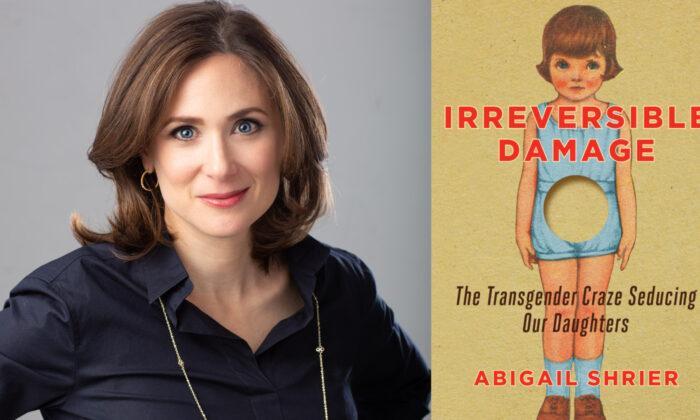Abigail Shrier includes in all her interviews something that no one else seems to say: Today’s trans activists don’t seem to represent the transgender adult population at all. Activists are by definition on the extreme side of issues, but in just the past few years, trans activists’ narratives have taken over any and all discussion, and the result has been costly.
In hundreds of cases, the result has been irreversible damage done to a growing population of teenage girls, as Shrier explores in her recent book, “Irreversible Damage: The Transgender Craze Seducing Our Daughters.”
After writing a 2017 op-ed that touched on trans activism, which was really about freedom-of-speech issues, Shrier heard from a mother whose daughter’s life had been hijacked by the narrative. It would be a few months before Shrier decided to take on the issue, and a second op-ed she wrote provoked a thousand comments.
Since then, Shrier has spoken to a wide range of people swept up in the craze—from experts whose professions have been upended, to popular trans influencers, to the people putting gender ideology into schools—and the nearly 200 interviews shape a story that has too long been censored.
“The story here is, we have an absolute epidemic of teenage girls who do not seem to have typical gender dysphoria at all, nonetheless convincing themselves they have gender dysphoria, convincing their friends, and rushing to hormones and surgeries. They are the largest and fastest-growing demographic, and this is throughout the West,” Shrier said.

False Diagnosis
We know what gender dysphoria looks like because we have data about it going back more than 100 years. What teenage girls are exhibiting today isn’t that.Dr. Lisa Littman, also interviewed in the book, was the first to publish a report on the spike in teen girl cases, coining the term “rapid-onset gender dysphoria” (ROGD), and she was quickly silenced. Social media abuse piled on, and then professional consequences followed, as her peer-reviewed paper was pulled. But meanwhile, hundreds of families realized for the first time that the nightmare they were suffering wasn’t unique.
Gender dysphoria is a disorder that can be treated. It typically occurs at a very young age (2 to 4), and almost always in boys. These children, historically 0.01 percent of the population, exhibit extreme distress with their biological sex. About 70 of these cases are resolved in childhood, but others persist painfully into adulthood. Sometimes, it is tied to trauma, and sometimes not at all. Hormones and surgery to cosmetically change the patient’s physical body are but one path he or she may take to cope with the dysphoria.
What we’ve seen in the past decade is the phenomenon of adolescent and teen girls who have had no history of childhood gender dysphoria suddenly, and in groups, come out as transgender, and then they are fast-tracked toward hormones and surgery. In the UK, for instance, from one year to the next, cases went up 4,500 percent. In fact, this phenomenon follows a pattern seen among teenage girls many times throughout history.
Instead, what the girls are often suffering from is anxiety, depression, adolescence itself—an emotionally turbulent time when children grow into new bodies—and a culture that has demoted women.
Shrier spoke to about 50 families whose daughters have self-diagnosed as trans, and their stories are strikingly similar. The stories are so similar, in fact, that Shrier worried that someone might mistake an entirely different family in the book for their own, and, feeling betrayed, would cut their own families off. If the typical narrative is that teens who come out as trans get cut off by their unsupportive families, Shrier completely upends that lie as well.
Instead, these are typically wildly supportive and mostly progressive families who are veritable cheerleaders for their daughters. But when they question whether their children really should start taking testosterone or get surgery right now, the children may get up in arms and stop communicating with their parents (who then continue to support them financially).
Continual Discomfort
If all the girls were doing was declaring themselves trans, these parents wouldn’t be exhibiting the absolute terror and heartbreak they share in anonymous stories online and in Shrier’s book. But unlike during past hysterias, these girls also live in a culture and system that seems entirely all too prepared to aid them on their biologically damaging journeys. It begins from a young age, inside schools.Shrier’s book handles the subject rationally, with sensitivity and empathy, and she came to sympathize with many of the people she talked to. When it came to the schools, however, she was shocked.
“The schools are incredibly hard to reach,” Shrier said. The schools intentionally, and effectively, shut parents out or purposely mislead them. In her state, parents protested to remove certain books they felt were inappropriate, and she later found that at least one of those books secretly made it back in through the school’s virtual library. Shrier has been hung up on multiple times and was barred from a training event for principals on gender ideology; even legislators pushing school policies wouldn’t speak with her. But the interviews she did get and include in the book are illuminating.
In order to teach what it means to be “gender non-conforming” (a sign you may be trans), schools must first teach what it means to be gender-conforming, and they do so in a baffling and regressive way.
“It reduces all women to stereotypes. If you don’t like pink, you’re gender non-conforming; if you like math, you’re gender non-conforming; if you excel at sports, you’re gender non-conforming,” Shrier said. “They are boxing young girls into the tiniest little spaces of acceptability. It is really one of the cruelest and most anti-female ideologies that I’ve seen in my lifetime.”
She writes that the whole history of women’s accomplishments is being erased in schools as these figures are instead celebrated for daring to be gender non-conforming.
At a time when teens, and the culture at large, seem more progressive than ever, one might assume that everyone under the LGBT umbrella is seen to have equal status, but women have been demoted there as well. One teen told Shrier that lesbians are just seen as masculine girls who can’t admit they’re boys, that it’s “not cool” and it’s “a porn category.”
So when these girls—who are typically intellectually precocious, artistic, and anxious—suffer a social setback (for example, when their pictures are judged on social media, or when they experience bullying or being left behind by their friend group), it isn’t that hard to see why they would cling to a minority group that gives them victim status (an upgrade in social hierarchy) and a peer group that enthusiastically celebrates their new identity. It’s one theory for why entire college campuses will have 40 to 50 percent of the student body declaring to be LGBT, when historically the demographic makes up 10 percent of the population.
Some of these teen girls met a new friend at school who later learn came out as trans, while others fell into social media communities that pushed trans activism. These online mentors coach teens into preparing a backstory about how they have always experienced gender dysphoria but never shared this because they didn’t feel safe at home. The teens learn that if they say they’re at risk of suicide, they’re all but guaranteed to get what they’re asking for from schools, therapists, and their parents.
The activists teach us that the keyword here is “affirm.” If a 12-year-old girl declares herself trans, her word must be treated as gospel. The school must affirm her pronouns and new name (without telling her potentially unsupportive parents, of course), therapists must affirm her self-diagnosis, and parents ought to affirm their new son if they wouldn’t rather have a dead daughter.
Therapists are put in a strange position; some are activists themselves and are all too happy to tell a girl and her parents that she is trans. Others fear that they don’t have the expertise to handle gender dysphoria, or that being anything less than “affirming” will lead to accusations that they practice “conversion therapy” and the eventual loss of their license. Still others may be taken in by teens’ carefully constructed backstories and threats of suicide.
If a girl hasn’t gone through puberty yet, her parents are advised to start her on puberty blockers. These drugs are recommended to parents as a benign “pause button” on puberty to buy them time, without any warning that the drugs, originally developed as a chemical castrator, mimic the effects of a pituitary tumor. Blocking puberty doesn’t just stop physical growth—it stunts neurological development as well. And if the young girl didn’t feel comfortable with her body pre-puberty, she is apt to feel even less so as all her friends around her start to go through puberty and she feels left behind and disconnected.
Parents usually aren’t told that nearly 100 percent of children starting puberty blockers go on to use cross-sex hormones.
If the girls are older and have already gone through puberty, they will likely try to purchase chest binders, which can cause them difficulty with breathing and even tissue damage. Then they start on testosterone (“T,” in slang terminology), which has permanent effects, such as a deepened voice and hair growth, that persist even after one stops taking the hormones. And if the parents don’t help these girls get hormones, the schools will—secretly, and sometimes without even leaving campus.
The drug comes with serious health risks, which are often glossed over.
“I interviewed a lot of transgender influencers—these are people in their 20s, usually—who are influencing and encouraging transition among a young population very effectively and very aggressively,” Shrier said. They share and overshare with their followers, and nonchalantly encourage them to try cross-sex hormones even if they’re not sure they’re trans, but only because they seem not to fully grasp the complications either. “I came to have more sympathy for them because I saw how lost some of these young people were, how well-meaning but lost.”
Testosterone also has the initial effect of alleviating anxiety and depression, which is often what these girls need treatment for in the first place. They thus experience a high once they start, which convinces them they are on the right path.
But testosterone also needs to be taken very regularly. It shuts down the menstrual cycle and directs the uterine lining to be shed, so when the girl forgets to take the hormone injections on time, her menstrual cycle starts up again and the fast-growing uterine lining means there is a higher risk of cell mutation, leading to endometrial cancer. This means that many who start on testosterone will in a few years opt to get surgery to also remove their uterus and ovaries, resulting in sterility.
Activists often reassure people that not all trans people get surgeries, and this is true, but those that do often get multiple surgeries, and these tend to be risky and specialized surgeries not every surgeon should be performing.
“Because it comes from a discomfort of not looking like the biological sex, the surgeries run on and on. It’s not one surgery that makes you look like a man; very often, patients will go back for several surgeries,” Shrier said. After “top surgery,” a voluntary double mastectomy (a procedure with questionable ethics, as surgeons are taking away a biological function), these girls realize their hips are too wide, because it’s not just that every cell of the body contains proof of one’s biological sex—bone structure is a dead giveaway as well. And then genital surgeries (“bottom surgery”) are microsurgeries of such a specialized field that not working with the best surgeons all but guarantees a botched surgery.
Hormones and surgery aren’t just presented as a quick fix to these girls’ problems; if they declare they are trans, there is also peer pressure to prove it.
Shrier notes, through conversations with some of these influencers, that not all girls trying to transition want to become boys. In fact, the teen girls displaying ROGD don’t seem to want to be boys at all. What they want to be is “not a girl,” to not have every part of their body judged and publicly shamed and suffer being part of a social class that is “less than.”
Sense With Children
Shrier knew she was telling a story that a population of parents desperately wanted to share, but she didn’t realize how much support she would be receiving from transgender adults as well.“In some sense, that surprised me the most, how many wonderful transgender adults have reached out and said, ‘Listen, I agree with you; what I went through has nothing to do with this sudden explosion of transgender enthusiasm from teenage girls, and it’s hard for me to say so publicly, but these teenage girls should not be able to walk into an informed consent clinic and walk out that day with testosterone. It’s irresponsible,’” Shrier said. They don’t think this phenomenon is something to celebrate.
It’s no wonder these trans adults feel silenced, when mainstream media ignores their stories, Shrier said. When her book was published, Amazon refused to run ads for it and sold search terms to books that told the opposite story, celebrating teen girls’ transitioning. “Irreversible Damage” became the top-selling LGBT book anyway. It’s rare to find a book that talks about gender and isn’t political, but Shrier eschews politics and ideology for the truth.
While Shrier’s book gives an inside look at the medical journey of transitioning, it is largely an exploration of culture, examining where we are and how we got here.
“Remember that we’re not having many kids in our society anymore,” she said. “We’ve dropped precipitously in population growth, and we just don’t seem to exhibit a lot of sense with children.
“So we treat, for some reason, some young girl’s announcement that she may have come up with online at age 11 as very serious. She’s almost treated like a prophet.”
It makes even less sense when we remember today’s teens act emotionally and mentally younger than those of their age would have a generation ago.
“And of course, if you’ve ever raised a child, it encourages a certain amount of skepticism that 11-year-olds know very much about themselves at all. But unfortunately, we just don’t have very many of those people with sense about children in our society today,” she said.
Gen X parents tend to be progressive and therapeutic. The same parents who are taken aback when their daughter declares she’s a boy had been fully supportive when she came out as pansexual or bisexual or a lesbian a year before. Shrier is a Gen X parent herself, and hearing these stories one after another gave her pause. What does an 11-year-old who has never kissed or dated really know about her sexuality? Identity isn’t something you obtain after doing a bit of social media research.
“Setting guidelines, setting limits on their kids is what they’re there for,” Shrier said. Parents shouldn’t go along with every announcement their kids make, and more importantly, they shouldn’t let their kids post these announcements online, “where they can be reached by all kinds of adults, some of whom are primed to take advantage.”
“Also when they make announcements online, on social media, about their gender or sexuality, it tends to make an adolescent feel locked into that identity, [as if] they can never change their minds,” she said.
In that vein, young teens probably shouldn’t be on social media anyway. Shrier references research discussed in Jean Twenge’s book “iGen” that showed explosions in anxiety, depression, and self-harm linked to social media use. Twenge’s findings were uncomfortable and drew controversy initially as well, but they took hold because they’re undeniably true.
“There are schools that have pacts where they all agree to keep their kids off social media as a condition for being at that school. I don’t see why we couldn’t do more of that,” Shrier said.
Parents aren’t the only ones who can oppose gender ideology in schools, she adds.
“I have talked to parents in the toniest private schools who told me that within the space of a year their daughters had three or four transgender speakers address the student body, and lo and behold, the seventh-grade class then had an explosion of transgender identification. There’s no reason for this. It’s confusing an entire population of kids,” Shrier said.
“And another thing is, people have to tell their daughter how great it is to be a girl and a woman. Because it is.
“Unfortunately we’ve forgotten that. We’ve forgotten that women have it actually great in America, and that there have been so many brave women who weren’t always perfectly feminine, and they’re great role models for our daughters, and that being a woman is a wonderful thing to be.”







Friends Read Free